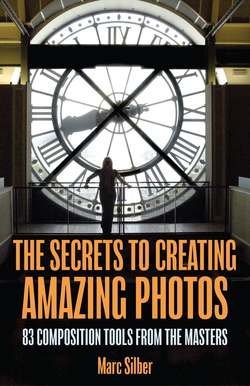Читать книгу The Secrets to Creating Amazing Photos - Marc Silber - Страница 4
На сайте Литреса книга снята с продажи.
ОглавлениеHow to Use This Book to Create Amazing Photos
“Every picture tells a story don’t it?”
—Rod Stewart
While every picture has the potential to tell a story, some really do and others … not so much. The photos that make you stop, look, and say “amazing” are the ones that tell their story the best.
And then there are the photos you pass by that don’t seem to have much to say at all … or do they?
No matter what camera you’re using, the two main skills to tell your story are composition and lighting.
There is a common misconception that composition is either intuitive or a gift that you have or you don’t, which can tend to block someone from learning about it. Another block comes from the pendulum swing from two extremes:
A.There are no rules to composition, you just sort of “feel” your way there; or,
B.There are nothing but rules and “laws” that will give you a formula to make your photo look amazing.
I believe that neither extreme is correct and, as with most things in life, the middle course is where you want to be. The way this works out is that you should know the composition guides, become familiar with them just as a musician learns his scales, and then start to practice until they come naturally to you and you can fluidly and, yes, intuitively work with them. But before you get to that stage it helps to have structure and a guidebook. This entire discussion holds true for use of natural lighting as well.
First of all, let’s define composition: It means how you place your subject or subjects within the frame of your camera in order to best tell your visual story. The derivation of composition in Latin is “put together.” You’re putting the subject of your photograph together in your camera space in order to communicate what you saw and felt to your viewers.
Composition is similar to cooking, where the same ingredients can be combined in a number of ways for a wide variety of outcomes: flour, baking powder, salt, water, and butter can be made into pancakes for breakfast, or biscuits for lunch, or an angel food cake for dinner. The same basic ingredients, with many different outcomes.
As you’ll see, there are many core ingredients to composition that you can use individually or in combination, with the same subjects to tell your story in an infinite number of ways.
Let’s think of these as “recipes” or tools that you can learn to use and have at your fingertips. The more fluid you are with them, the more you’ll be able to utilize them in imaginative ways to make creative photos. I’m making these easily available to you to help you expand your creative skills in each.
As you’ll see, the book defines 83 composition tools for easy use, each illustrated by one or more photographs or other works of art. As a note, these illustrations serve several purposes: first to show the tool being discussed, but also you’ll find many interesting examples of composition that you can learn from. For some, I selected paintings going back many centuries to underscore the duration of these tools from the masters.
There are three ways to use this book:
1.Start at #1, study each tool, and then create your own examples all the way through the book. Then you’ll have real experience with each of them.
2.Read through the book to get a feel for these and take notes on the ones that resonate with you. Once you’ve done this, the best action to reinforce the concepts presented is to immediately pull out your camera or phone and try to create with that composition “recipe.” Since the book is compact, I want you to carry it with you and put it right to use as you’re going out and photographing—it’s not meant to sit on a shelf and gather dust.
3.The third approach would be—just as if you were learning French cooking from Julia Child—looking through the book to find a recipe that catches your eye, and then simply cooking it. You might be challenged by one and put yourself to the test to see if you can make a credible version of it, and hopefully find you exceeded your expectations.
In any case, my goal is to broaden you skills as a photographer, no matter what level you are when you enter this process. I want to help you fulfill that deep urge that I spoke of to tell stories with your pictures and share them with pride as prints, exhibits, in books you create, on your social media, and elsewhere.
Then, start sharing your photos with us so we can see your results and hear your stories behind your images. To do so, use the hashtag #AYPClub (as I started with my previous book Advancing Your Photography (AYP).
